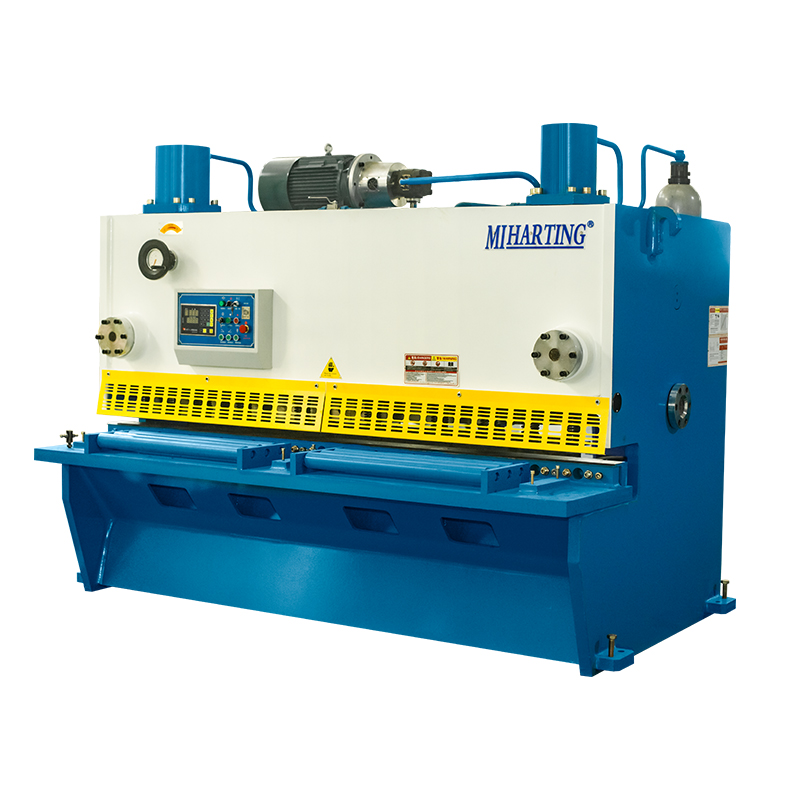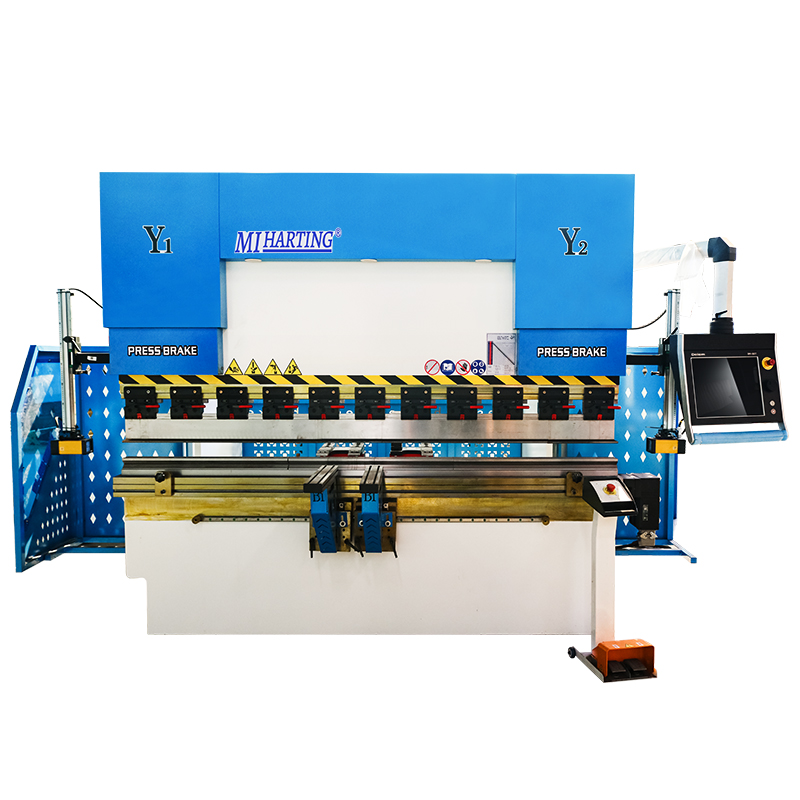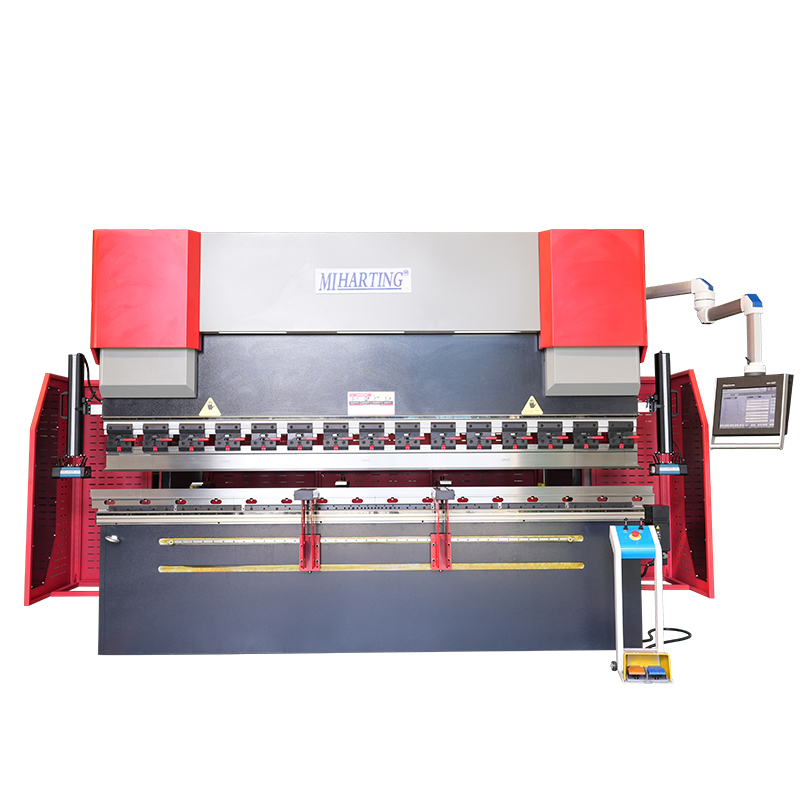عندما يتعلق الأمر بتشكيل الصفائح المعدنية، اضغط على الفرامل تعد آلات أساسية تستخدم لثني المعادن إلى أشكال مختلفة. هناك نوعان شائعان من مكابس الثني هما: الفرامل الصحافة باستخدام الحاسب الآلي و مكابس الضغط NCعلى الرغم من أن كلاهما يخدم نفس الغرض الأساسي، إلا أنهما يختلفان بشكل كبير من حيث التكنولوجيا والدقة والأتمتة والتحكم.
في هذه المقالة سوف نقوم بالمقارنة الفرامل الصحافة باستخدام الحاسب الآلي و مكابس الضغط NC بالتفصيل. سوف نستكشف الاختلافات الرئيسية بينهما وميزاتهما وتطبيقاتهما، مما يساعد الشركات المصنعة على تحديد النظام الأفضل الذي يناسب احتياجات إنتاجها.
ما هي آلة الكبح بالضغط CNC؟
الفرامل الصحافة باستخدام الحاسب الآلي (التحكم الرقمي بالحاسوب) هي آلات متقدمة للغاية يتم التحكم فيها رقميًا وتوفر دقة وأتمتة فائقة. مع تكنولوجيا التحكم الرقمي بالكمبيوترتستخدم هذه الآلات نظام كمبيوتر للتحكم في وضع مكبس مكابح الضغط وعملية الانحناء. مكابس الضغط CNC توفر المرونة اللازمة لتنفيذ تسلسلات الانحناء المعقدة مع إمكانية تكرار عالية، مما يجعلها مناسبة للمهام التي تتطلب تصميمات دقيقة ومعقدة.
الميزات الرئيسية لآلات الكبح CNC:
- التحكم الآلي: عملية آلية بالكامل باستخدام البرمجة الرقمية والبرمجيات.
- دقة عالية: يوفر تحكمًا دقيقًا للغاية في التسامح، مما يجعله مثاليًا للأعمال المعقدة.
- تسلسلات الانحناء القابلة للبرمجة: قادرة على تخزين برامج الانحناء المتعددة لإجراء تغييرات سريعة في الإنتاج.
- واجهة شاشة اللمس: برمجة وتحكم أسهل عبر واجهة تفاعلية وسهلة الاستخدام.
- براعه: يمكن استخدامها لمهام الانحناء البسيطة والمعقدة.
- ميزات السلامة المتقدمة: يتضمن أجهزة استشعار آلية وحصائر أمان وحراسة لضمان سلامة العمال.
ما هي مكبس الثني NC؟
ان فرملة الضغط NC (التحكم الرقمي) هو إصدار أكثر أساسية من مكبس الثني CNC. يتم التحكم فيه من خلال مجموعة من التعليمات الرقمية، لكن نظام التحكم أقل تطورًا مقارنة بإصدار CNC. مكابس الضغط NC تعتمد هذه الآلات عادةً على إدخال يدوي للبرمجة، والذي يمكن إجراؤه من خلال لوحة مفاتيح أو واجهة أساسية. غالبًا ما تكون هذه الآلات أكثر تكلفة وأسهل في الصيانة ولكنها قد لا توفر نفس مستوى المرونة أو الأتمتة أو الدقة مثل مكبس الثني CNC.
الميزات الرئيسية لآلات الكبح NC:
- البرمجة اليدوية: يتم إجراء البرمجة عادةً عبر لوحة مفاتيح أو أزرار على لوحة التحكم.
- دقة أقل: يوفر تحكمًا أقل دقة في عملية الانحناء مقارنة بأنظمة CNC.
- عملية أبسط: أسهل في الاستخدام ولكن مع إمكانيات أقل للمهام المعقدة.
- مرونة محدودة: أكثر ملاءمة لعمليات الانحناء البسيطة والمتكررة.
- فعالة من حيث التكلفة: أقل تكلفة من أنظمة CNC، مما يجعلها مثالية للشركات ذات الاحتياجات ذات الحجم الأقل.
مقارنة تفصيلية بين مكبس الثني CNC ومكبس الثني NC
لتوفير تفصيل واضح وسهل الفهم للاختلافات بين مكابس الثني CNC وNC، إليك جدول مقارنة يسلط الضوء على الجوانب الرئيسية:
| ميزة | الفرامل الصحافة باستخدام الحاسب الآلي | مكابس الضغط NC |
| نظام التحكم | أوتوماتيكية بالكامل مع التحكم بالكمبيوتر | شبه آلي مع التحكم الرقمي الأساسي |
| واجهة البرمجة | شاشة تعمل باللمس متقدمة مع تخزين البرامج | إدخال لوحة المفاتيح أو الأزرار الأساسية |
| الدقة والضبط | دقة عالية مع التحكم في التسامح الدقيق | دقة متوسطة مع دقة أقل من CNC |
| تعقيد العمليات | قادرة على تنفيذ عمليات الانحناء المعقدة | مناسب للمهام البسيطة والمتكررة |
| مستوى الأتمتة | مؤتمتة بالكامل مع الحد الأدنى من التدخل اليدوي | يتطلب تعديلات البرمجة اليدوية |
| المرونة | مرن للغاية، ويمكنه تخزين برامج متعددة | أقل مرونة، مصمم بشكل أساسي للانحناءات القياسية |
| يكلف | أغلى ثمناً بسبب التكنولوجيا المتقدمة | أكثر بأسعار معقولة وفعالية من حيث التكلفة |
| صيانة | يتطلب المزيد من الخبرة الفنية للصيانة | أسهل في الصيانة واستكشاف الأخطاء وإصلاحها |
| التطبيقات | مناسب للمهام عالية الدقة ومنخفضة الحجم والمخصصة | الأفضل لمهام الانحناء القياسية ذات الحجم المتوسط إلى المرتفع |
| ميزات السلامة | آليات السلامة المتقدمة (على سبيل المثال، أجهزة الاستشعار، التوقف التلقائي) | ميزات السلامة الأساسية (على سبيل المثال، زر التوقف في حالات الطوارئ) |
الفوائد الرئيسية لآلات الكبح CNC
-
دقة فائقة: توفر مكابس الثني CNC دقة استثنائية، غالبًا في حدود 0.001 بوصة، وهو أمر بالغ الأهمية للصناعات التي تتطلب تحمُّلات ضيقة، مثل تصنيع الطائرات والسيارات والإلكترونيات.
-
كفاءة محسنة: بفضل تسلسلات الانحناء الآلية والقدرة على برمجة وتخزين عمليات متعددة، تعمل مكابس الثني CNC على تقليل وقت التوقف عن العمل بشكل كبير وتحسين الإنتاجية الإجمالية.
-
المرونة في الإنتاج: إن القدرة على العمل مع الأشكال الهندسية المعقدة والمواد المختلفة تجعل مكابس الثني CNC مناسبة للنماذج الأولية والتصنيع المخصص، حيث قد يكون لكل مهمة متطلبات فريدة.
-
انخفاض تكاليف العمالة: نظرًا لأن ماكينات CNC مؤتمتة بالكامل، فإن الحاجة إلى عدد أقل من المشغلين وتكاليف العمالة تكون ضئيلة. ويمكن للماكينة أن تعمل طوال الليل، مما يحسن الكفاءة التشغيلية.
تطبيقات مكابس الثني CNC
- تصنيع الطيران والفضاء: بفضل دقتها وقدرتها على التعامل مع الأجزاء المعقدة، تعد مكابس الثني CNC مثالية لتشكيل الصفائح المعدنية المستخدمة في صناعة الطائرات.
- صناعة السيارات: تُستخدم مكابس الضغط CNC لإنتاج مكونات السيارات المعقدة التي تتطلب دقة عالية.
- الهندسة الإلكترونية والدقيقة: تعتبر مكابس الثني CNC مثالية لثني الأجزاء الصغيرة والمعقدة ذات التفاوتات الضيقة، وتستخدم على نطاق واسع في الصناعات مثل الإلكترونيات وتصنيع الأجهزة الطبية.
- تصنيع حسب الطلب: تُعد مكابس الثني CNC الخيار الأمثل لصانعي القطع المخصصة الذين يحتاجون إلى المرونة والدقة لإنتاج دفعات صغيرة.
الفوائد الرئيسية لآلات الثني ذات الضغط العالي
-
فعالة من حيث التكلفة: نظرًا لأن مكابس الثني ذات التحكم الرقمي تفتقر إلى أنظمة التحكم الحاسوبية المتقدمة الموجودة في نماذج التحكم الرقمي، فهي أقل تكلفة بشكل عام، مما يجعلها خيارًا جيدًا للشركات ذات الميزانية المحدودة.
-
سهولة الاستخدام: تتمتع مكابس الثني ذات التحكم الرقمي بنظام تحكم أبسط، مما يجعل من السهل على المشغلين تعلمها واستخدامها. وهذا مفيد بشكل خاص في العمليات الأقل تطلبًا.
-
مثالي للانحناء المتكرر: تتميز مكابس الثني ذات التحكم الرقمي بالتفوق في العمليات التي يتم فيها تكرار نفس مهام الانحناء أو مهام مماثلة عبر حجم كبير من الأجزاء، كما هو الحال في إنتاج الصناديق أو الألواح أو الإطارات البسيطة.
-
انخفاض تكاليف الصيانة: بفضل التكنولوجيا البسيطة، غالبًا ما تكون مكابس الثني ذات التحكم الرقمي أسهل وأقل تكلفة في الصيانة.
تطبيقات مكابس الثني ذات التحكم الرقمي
- ثني الصفائح المعدنية الأساسية: تُستخدم مكابس الثني ذات التحكم الرقمي غالبًا في الصناعات التي تحتاج إلى ثني ثابت للمكونات الأقل تعقيدًا مثل الأقواس والحاويات والإطارات البسيطة.
- التصنيع بكميات كبيرة: مثالي للمهام التي تتطلب إنتاج كميات كبيرة من الأجزاء القياسية، وخاصة في قطاعات مثل البناء أو تصنيع الأثاث.
- محلات التصنيع العامة: غالبًا ما تستخدم متاجر تصنيع المعادن الصغيرة والمتوسطة الحجم مكابس الضغط NC لإنتاج كميات كبيرة من الأجزاء المعدنية البسيطة.
أيهما يجب عليك أن تختار؟
الاختيار بين مكابس الضغط CNC و فرملة الضغط NC يعتمد الأمر في النهاية على احتياجات الإنتاج الخاصة بك وميزانيتك.
- اختر مكابس الضغط CNC إذا كانت عملياتك تتطلب دقة عالية، أو هندسة معقدة، أو وظائف مخصصة، وإذا كنت مستعدًا للاستثمار في الأتمتة المتقدمة.
- اختر واحد فرملة الضغط NC إذا كنت تبحث عن حل موثوق به وفعال من حيث التكلفة لمهام الانحناء المتكررة عالية الحجم والتي لا تتطلب مستوى الدقة الذي توفره أنظمة CNC.
إن فهم الاختلافات بين هذين النوعين من مكابس الثني يمكن أن يساعدك في اتخاذ قرار مستنير وتحسين قدراتك الإنتاجية.






